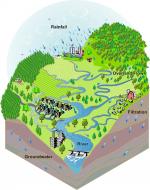|
This section contains 1,034 words (approx. 4 pages at 300 words per page) |

|
An ecosystem consists of a biological community and the abiotic factors on which it relies. These factors include sunlight, water, elements, and minerals. Energy flows one way through an ecosystem, starting as sunlight absorbed by primary producers, passing through several levels of consumers, and eventually dissipating as heat. Materials cycle through an ecosystem by alternating between biotic and abiotic stages.
The sun is the ultimate source of energy for most ecosystems. The distribution of solar energy around the world is dictated by the position of the sun and air and water movement. The variation in solar energy causes variation in temperature and rainfall in time and space, which in turn influences the type of ecosystem found in each place.
Ecosystems contain interconnected food chains known as food webs through which energy flows. Each food chain consists of a sequence of predator-prey relationships at different trophic levels. Each predator...
|
This section contains 1,034 words (approx. 4 pages at 300 words per page) |

|


